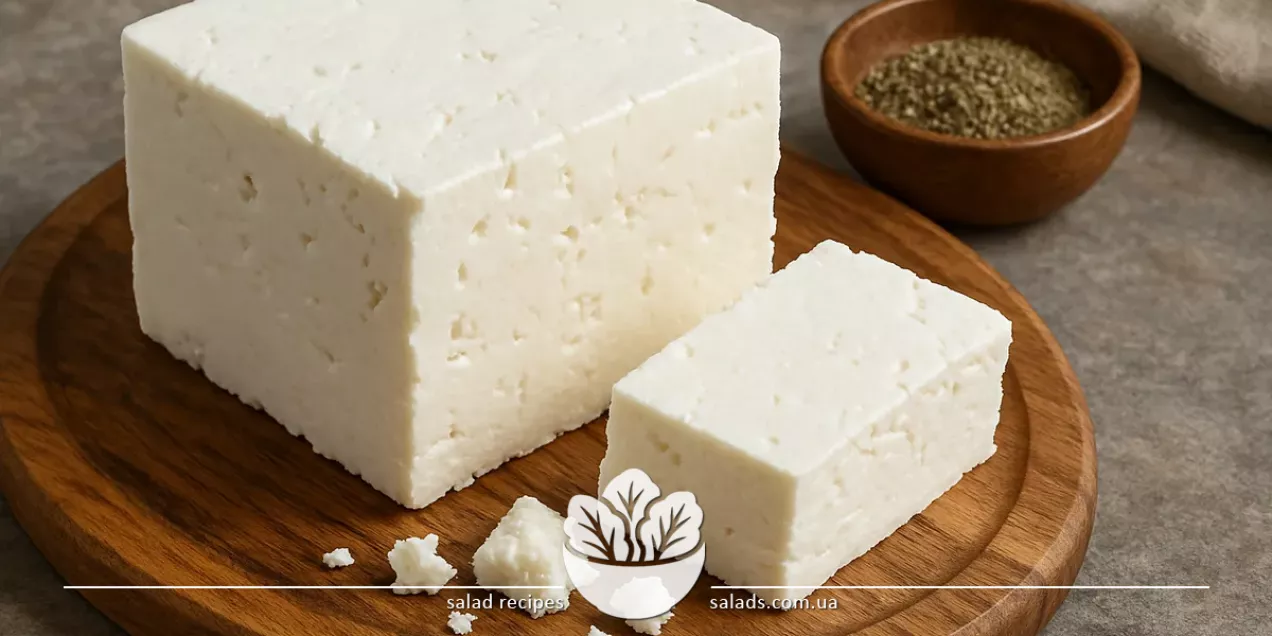
Feta Cheese

Feta cheese is a traditional Greek brined cheese that is now appreciated worldwide for its bold taste, saltiness, and delicate texture. It is made from sheep’s milk or a blend of sheep and goat milk, and aged in brine for several weeks. Feta is characterized by a grainy texture, white color, and slightly tangy flavor. In cooking, it is used not only in salads but also in hot dishes, appetizers, baked goods, and spreads. You can find more cheese varieties in the cheese section of our catalog.
Salad Recipes with Feta Cheese
Origin, Traditions, and Uniqueness
Feta cheese has a history that spans over 2,000 years. It was mentioned in ancient Greece, where it was made from sheep’s milk and preserved in brine – a method that allowed it to stay fresh in the warm Mediterranean climate. Today, feta has a protected designation of origin in the European Union, and only cheese produced in Greece following traditional methods may bear the name. Feta has a crumbly texture, a rich aroma, and a salty, slightly tangy taste that is hard to mistake. Thanks to its natural composition – with no preservatives but a high salt content – it stays fresh for a long time in sealed packaging, especially when stored in its brine. This structure makes it ideal for salads and appetizers that require a bold cheese note that won’t get lost among other ingredients. In Greek cuisine, feta is served with tomatoes, olives, oregano, and olive oil, but in everyday meals it’s also combined with simple ingredients like garlic, which enhances the aroma and complements the taste, especially in baked dishes or sauces.
Feta in Salads and Cold Dishes
Feta cheese is best known as a key ingredient in Greek salad, but its use in cold dishes is much broader. Thanks to its salty taste and crumbly texture, feta pairs well with vegetables, herbs, olives, hard-boiled eggs, legumes, and even fruits – especially grapes, pears, or figs. This allows for both classic and creative culinary combinations. Vegetarian salads with feta are not only delicious but also nutritious, as the cheese is rich in protein and calcium. Feta brings harmony to dishes with contrasting textures – soft vegetables and crunchy toppings. That’s why it is often paired with nuts, seeds, and grains. One of the most popular combinations is feta with walnuts. This duo offers a well-balanced flavor and rich texture: the softness of the cheese contrasts with the crunch of the nuts, and the saltiness balances their mild bitterness. This pairing is ideal for salads, sandwiches, and cheese boards.
Baked and Hot Dishes with Feta
While feta is most often used fresh, it also works wonderfully in baked dishes. Due to its high protein content and firm structure, it doesn’t melt completely when heated but rather softens while maintaining its shape. This makes it perfect for oven dishes – from vegetable bakes to stuffed peppers, rolls, pies, or filled breads. In Mediterranean cuisine, feta is often baked in foil with tomatoes, peppers, spices, and olive oil – a simple recipe that brings out the full depth of its flavor. Vegetarian lasagna or hot sandwiches with feta offer a soft yet bold taste without the need for extra processing. In meat-based dishes, feta adds a contrasting note of saltiness and creaminess. It pairs especially well with vegetables that have natural sweetness. For example, in a baked dish with carrots and potatoes, feta balances the sweetness of the roots with its tangy flavor. Such dishes are both hearty and refined – with no complex preparation required.
Combinations with Meat and Protein-Rich Foods
Although feta is traditionally associated with vegetable or vegetarian dishes, its flavor also pairs well with meat. Thanks to its saltiness, feta acts as a natural flavor enhancer, adding depth to meat – especially in recipes with a neutral or mild base. In Balkan and Mediterranean cuisines, it’s often combined with lamb, veal, chicken, or beef in casseroles, rolls, pies, and even soups. Feta can be added to meatball or cutlet fillings – providing juiciness and a mild creamy aroma. It can also be used as a stuffing – for example, in chicken breast or pork tenderloin rolls. Feta is also served as a topping – cubed or crumbled, it goes well with steaks and grilled meats. One especially harmonious pairing is feta with beef, particularly in dishes like Greek moussaka or baked casseroles with eggplant and tomatoes. In such recipes, the cheese doesn’t just complement the meat but becomes a key part of the flavor composition.
Unusual Uses: Spreads and Desserts
Though feta is typically used in salads and baked dishes, its culinary potential goes far beyond. Thanks to its crumbly texture, it easily transforms into a creamy spread or dip, especially when mixed with yogurt, sour cream, or soft cheeses. These mixtures work well for sandwiches, bruschetta, tartlets, or as an alternative to classic sauces in baked vegetable and meat dishes. Feta is also notable in sweet or sweet-and-savory recipes. Its natural saltiness provides an appealing contrast to fruits, honey, jams, or syrups. In Greek cuisine, feta is often used in puff pastry desserts with raisins, cinnamon, orange zest, or honey. Such dishes have a complex sweet and savory flavor profile. In homemade desserts, feta can even be paired with white sugar – in dishes like cheesecakes, baked creams, or mousses. Its texture and aroma allow for refined sweet snacks without expensive ingredients.

